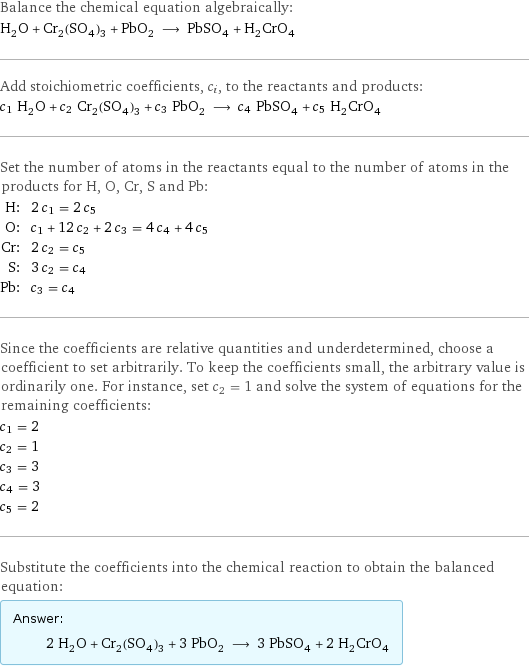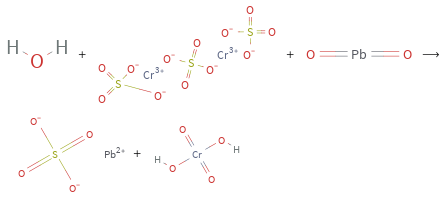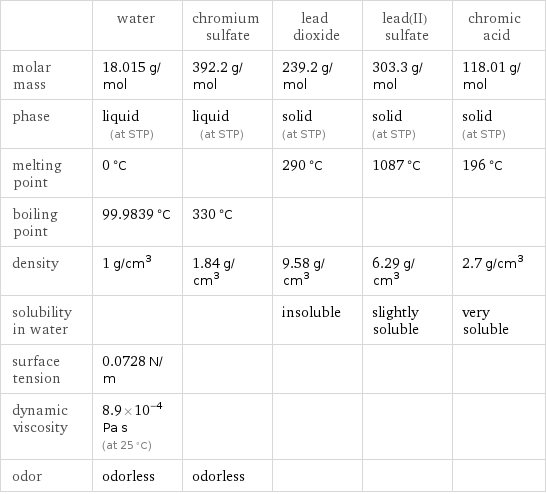Input interpretation

H_2O water + Cr_2(SO_4)_3 chromium sulfate + PbO_2 lead dioxide ⟶ PbSO_4 lead(II) sulfate + H_2CrO_4 chromic acid
Balanced equation

Balance the chemical equation algebraically: H_2O + Cr_2(SO_4)_3 + PbO_2 ⟶ PbSO_4 + H_2CrO_4 Add stoichiometric coefficients, c_i, to the reactants and products: c_1 H_2O + c_2 Cr_2(SO_4)_3 + c_3 PbO_2 ⟶ c_4 PbSO_4 + c_5 H_2CrO_4 Set the number of atoms in the reactants equal to the number of atoms in the products for H, O, Cr, S and Pb: H: | 2 c_1 = 2 c_5 O: | c_1 + 12 c_2 + 2 c_3 = 4 c_4 + 4 c_5 Cr: | 2 c_2 = c_5 S: | 3 c_2 = c_4 Pb: | c_3 = c_4 Since the coefficients are relative quantities and underdetermined, choose a coefficient to set arbitrarily. To keep the coefficients small, the arbitrary value is ordinarily one. For instance, set c_2 = 1 and solve the system of equations for the remaining coefficients: c_1 = 2 c_2 = 1 c_3 = 3 c_4 = 3 c_5 = 2 Substitute the coefficients into the chemical reaction to obtain the balanced equation: Answer: | | 2 H_2O + Cr_2(SO_4)_3 + 3 PbO_2 ⟶ 3 PbSO_4 + 2 H_2CrO_4
Structures

+ + ⟶ +
Names

water + chromium sulfate + lead dioxide ⟶ lead(II) sulfate + chromic acid
Equilibrium constant
![Construct the equilibrium constant, K, expression for: H_2O + Cr_2(SO_4)_3 + PbO_2 ⟶ PbSO_4 + H_2CrO_4 Plan: • Balance the chemical equation. • Determine the stoichiometric numbers. • Assemble the activity expression for each chemical species. • Use the activity expressions to build the equilibrium constant expression. Write the balanced chemical equation: 2 H_2O + Cr_2(SO_4)_3 + 3 PbO_2 ⟶ 3 PbSO_4 + 2 H_2CrO_4 Assign stoichiometric numbers, ν_i, using the stoichiometric coefficients, c_i, from the balanced chemical equation in the following manner: ν_i = -c_i for reactants and ν_i = c_i for products: chemical species | c_i | ν_i H_2O | 2 | -2 Cr_2(SO_4)_3 | 1 | -1 PbO_2 | 3 | -3 PbSO_4 | 3 | 3 H_2CrO_4 | 2 | 2 Assemble the activity expressions accounting for the state of matter and ν_i: chemical species | c_i | ν_i | activity expression H_2O | 2 | -2 | ([H2O])^(-2) Cr_2(SO_4)_3 | 1 | -1 | ([Cr2(SO4)3])^(-1) PbO_2 | 3 | -3 | ([PbO2])^(-3) PbSO_4 | 3 | 3 | ([PbSO4])^3 H_2CrO_4 | 2 | 2 | ([H2CrO4])^2 The equilibrium constant symbol in the concentration basis is: K_c Mulitply the activity expressions to arrive at the K_c expression: Answer: | | K_c = ([H2O])^(-2) ([Cr2(SO4)3])^(-1) ([PbO2])^(-3) ([PbSO4])^3 ([H2CrO4])^2 = (([PbSO4])^3 ([H2CrO4])^2)/(([H2O])^2 [Cr2(SO4)3] ([PbO2])^3)](../image_source/1ec289953ab83c0e53175d51802ac164.png)
Construct the equilibrium constant, K, expression for: H_2O + Cr_2(SO_4)_3 + PbO_2 ⟶ PbSO_4 + H_2CrO_4 Plan: • Balance the chemical equation. • Determine the stoichiometric numbers. • Assemble the activity expression for each chemical species. • Use the activity expressions to build the equilibrium constant expression. Write the balanced chemical equation: 2 H_2O + Cr_2(SO_4)_3 + 3 PbO_2 ⟶ 3 PbSO_4 + 2 H_2CrO_4 Assign stoichiometric numbers, ν_i, using the stoichiometric coefficients, c_i, from the balanced chemical equation in the following manner: ν_i = -c_i for reactants and ν_i = c_i for products: chemical species | c_i | ν_i H_2O | 2 | -2 Cr_2(SO_4)_3 | 1 | -1 PbO_2 | 3 | -3 PbSO_4 | 3 | 3 H_2CrO_4 | 2 | 2 Assemble the activity expressions accounting for the state of matter and ν_i: chemical species | c_i | ν_i | activity expression H_2O | 2 | -2 | ([H2O])^(-2) Cr_2(SO_4)_3 | 1 | -1 | ([Cr2(SO4)3])^(-1) PbO_2 | 3 | -3 | ([PbO2])^(-3) PbSO_4 | 3 | 3 | ([PbSO4])^3 H_2CrO_4 | 2 | 2 | ([H2CrO4])^2 The equilibrium constant symbol in the concentration basis is: K_c Mulitply the activity expressions to arrive at the K_c expression: Answer: | | K_c = ([H2O])^(-2) ([Cr2(SO4)3])^(-1) ([PbO2])^(-3) ([PbSO4])^3 ([H2CrO4])^2 = (([PbSO4])^3 ([H2CrO4])^2)/(([H2O])^2 [Cr2(SO4)3] ([PbO2])^3)
Rate of reaction
![Construct the rate of reaction expression for: H_2O + Cr_2(SO_4)_3 + PbO_2 ⟶ PbSO_4 + H_2CrO_4 Plan: • Balance the chemical equation. • Determine the stoichiometric numbers. • Assemble the rate term for each chemical species. • Write the rate of reaction expression. Write the balanced chemical equation: 2 H_2O + Cr_2(SO_4)_3 + 3 PbO_2 ⟶ 3 PbSO_4 + 2 H_2CrO_4 Assign stoichiometric numbers, ν_i, using the stoichiometric coefficients, c_i, from the balanced chemical equation in the following manner: ν_i = -c_i for reactants and ν_i = c_i for products: chemical species | c_i | ν_i H_2O | 2 | -2 Cr_2(SO_4)_3 | 1 | -1 PbO_2 | 3 | -3 PbSO_4 | 3 | 3 H_2CrO_4 | 2 | 2 The rate term for each chemical species, B_i, is 1/ν_i(Δ[B_i])/(Δt) where [B_i] is the amount concentration and t is time: chemical species | c_i | ν_i | rate term H_2O | 2 | -2 | -1/2 (Δ[H2O])/(Δt) Cr_2(SO_4)_3 | 1 | -1 | -(Δ[Cr2(SO4)3])/(Δt) PbO_2 | 3 | -3 | -1/3 (Δ[PbO2])/(Δt) PbSO_4 | 3 | 3 | 1/3 (Δ[PbSO4])/(Δt) H_2CrO_4 | 2 | 2 | 1/2 (Δ[H2CrO4])/(Δt) (for infinitesimal rate of change, replace Δ with d) Set the rate terms equal to each other to arrive at the rate expression: Answer: | | rate = -1/2 (Δ[H2O])/(Δt) = -(Δ[Cr2(SO4)3])/(Δt) = -1/3 (Δ[PbO2])/(Δt) = 1/3 (Δ[PbSO4])/(Δt) = 1/2 (Δ[H2CrO4])/(Δt) (assuming constant volume and no accumulation of intermediates or side products)](../image_source/7f7cdbae77732717314a6e5e1ad3a09b.png)
Construct the rate of reaction expression for: H_2O + Cr_2(SO_4)_3 + PbO_2 ⟶ PbSO_4 + H_2CrO_4 Plan: • Balance the chemical equation. • Determine the stoichiometric numbers. • Assemble the rate term for each chemical species. • Write the rate of reaction expression. Write the balanced chemical equation: 2 H_2O + Cr_2(SO_4)_3 + 3 PbO_2 ⟶ 3 PbSO_4 + 2 H_2CrO_4 Assign stoichiometric numbers, ν_i, using the stoichiometric coefficients, c_i, from the balanced chemical equation in the following manner: ν_i = -c_i for reactants and ν_i = c_i for products: chemical species | c_i | ν_i H_2O | 2 | -2 Cr_2(SO_4)_3 | 1 | -1 PbO_2 | 3 | -3 PbSO_4 | 3 | 3 H_2CrO_4 | 2 | 2 The rate term for each chemical species, B_i, is 1/ν_i(Δ[B_i])/(Δt) where [B_i] is the amount concentration and t is time: chemical species | c_i | ν_i | rate term H_2O | 2 | -2 | -1/2 (Δ[H2O])/(Δt) Cr_2(SO_4)_3 | 1 | -1 | -(Δ[Cr2(SO4)3])/(Δt) PbO_2 | 3 | -3 | -1/3 (Δ[PbO2])/(Δt) PbSO_4 | 3 | 3 | 1/3 (Δ[PbSO4])/(Δt) H_2CrO_4 | 2 | 2 | 1/2 (Δ[H2CrO4])/(Δt) (for infinitesimal rate of change, replace Δ with d) Set the rate terms equal to each other to arrive at the rate expression: Answer: | | rate = -1/2 (Δ[H2O])/(Δt) = -(Δ[Cr2(SO4)3])/(Δt) = -1/3 (Δ[PbO2])/(Δt) = 1/3 (Δ[PbSO4])/(Δt) = 1/2 (Δ[H2CrO4])/(Δt) (assuming constant volume and no accumulation of intermediates or side products)
Chemical names and formulas

| water | chromium sulfate | lead dioxide | lead(II) sulfate | chromic acid formula | H_2O | Cr_2(SO_4)_3 | PbO_2 | PbSO_4 | H_2CrO_4 Hill formula | H_2O | Cr_2O_12S_3 | O_2Pb | O_4PbS | CrH_2O_4 name | water | chromium sulfate | lead dioxide | lead(II) sulfate | chromic acid IUPAC name | water | chromium(+3) cation trisulfate | | | dihydroxy-dioxo-chromium
Substance properties

| water | chromium sulfate | lead dioxide | lead(II) sulfate | chromic acid molar mass | 18.015 g/mol | 392.2 g/mol | 239.2 g/mol | 303.3 g/mol | 118.01 g/mol phase | liquid (at STP) | liquid (at STP) | solid (at STP) | solid (at STP) | solid (at STP) melting point | 0 °C | | 290 °C | 1087 °C | 196 °C boiling point | 99.9839 °C | 330 °C | | | density | 1 g/cm^3 | 1.84 g/cm^3 | 9.58 g/cm^3 | 6.29 g/cm^3 | 2.7 g/cm^3 solubility in water | | | insoluble | slightly soluble | very soluble surface tension | 0.0728 N/m | | | | dynamic viscosity | 8.9×10^-4 Pa s (at 25 °C) | | | | odor | odorless | odorless | | |
Units
